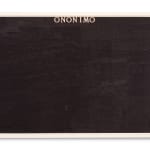
Alighiero Boetti Italian, 1940-1994
Ononimo, 1975
Ballpoint pen on card
70 x 100 cm. (27 1/2 x 39 3/8 in.)
Copyright The Artist
